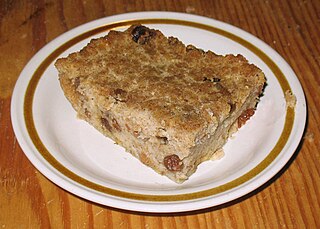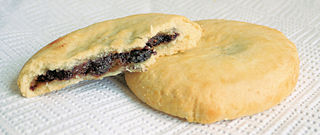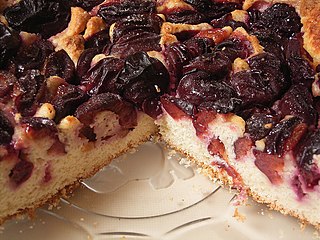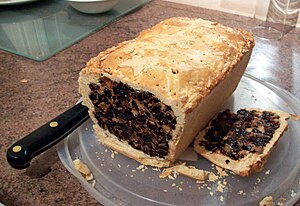
Bread pudding is a bread-based dessert popular in many countries' cuisines. It is made with stale bread and milk or cream, generally containing eggs, a form of fat such as oil, butter or suet and, depending on whether the pudding is sweet or savory, a variety of other ingredients. Sweet bread puddings may use sugar, syrup, honey, dried fruit, nuts, as well as spices such as cinnamon, nutmeg, mace, or vanilla. The bread is soaked in the liquids, mixed with the other ingredients, and baked.

A pie is a baked dish which is usually made of a pastry dough casing that contains a filling of various sweet or savoury ingredients. Sweet pies may be filled with fruit, nuts, fruit preserves, brown sugar, sweetened vegetables, or with thicker fillings based on eggs and dairy. Savoury pies may be filled with meat, eggs and cheese or a mixture of meat and vegetables.

Shortbread or shortie is a traditional Scottish biscuit usually made from one part white sugar, two parts butter and three to four parts plain wheat flour. Shortbread does not contain any leavening, such as baking powder or baking soda. Shortbread is widely associated with Christmas and Hogmanay festivities in Scotland, and some Scottish brands are exported around the world.

A king cake, also known as a three kings cake or a baby cake, is a cake associated in many countries with Epiphany, the celebration of the Twelfth Night after Christmas. Its form and ingredients are variable, but in most cases a fève such as a figurine, often said to represent the Christ Child, is hidden inside. After the cake is cut, whoever gets the fève wins a prize. Modern fèves can be made of other materials, and can represent various objects and people.

Rice pudding is a dish made from rice mixed with water or milk and commonly other ingredients such as sweeteners, spices, flavourings and sometimes eggs.

A cinnamon roll is a sweet roll commonly served in Northern Europe and North America. In Denmark it is known as kanelsnegl, in Sweden it is called kanelbulle, in Norway it is known as kanelbolle, skillingsbolle, kanelsnurr, or kanel i svingene, in Finland it is known as korvapuusti, in Iceland it is known as kanilsnúður, and in Estonia it is known as kaneelirull. In Austria and Germany, it is called Zimtschnecke. In Slovakia and the Czech Republic, it is called škoricové slimáky/skořicoví šneci.

Mixed spice, also called pudding spice, is a British blend of sweet spices, similar to the pumpkin pie spice used in the United States. Cinnamon is the dominant flavour, with nutmeg and allspice. It is often used in baking, or to complement fruits or other sweet foods.

Christmas cake is a type of cake, often fruitcake, served at Christmas time in many countries.

A saffron bun, Cornishtea treat bun or revel bun, is a rich, spiced yeast-leavened sweet bun that is flavoured with saffron and contains dried fruit including currants and raisins similar to a teacake. The main ingredients are plain flour, butter, yeast, caster sugar, currants and sultanas. Larger versions baked in a loaf tin are known as saffron cake.

Flies' graveyard and flies' cemetery are nicknames used in various parts of the United Kingdom for sweet pastries filled with currants or raisins, which are jokingly said to resemble dead flies. In Scotland, they are known as fly cakes, fruit slice or fruit squares and in Northern Ireland as currant squares. In the North East of England, the pastries are fly cakes or fly pie. In Wales it is called Cacen Pwdin ; and in New Zealand they are known as fruit slice or fly cemetery.

Chorley cakes are flattened, fruit filled pastry cakes, traditionally associated with the town of Chorley in Lancashire, England.

Scottish cuisine encompasses the cooking styles, traditions and recipes associated with Scotland. It has distinctive attributes and recipes of its own, but also shares much with other British and wider European cuisine as a result of local, regional, and continental influences — both ancient and modern.

Cardamom breads, including the Finnish pulla and Swedish kardemummabröd and kardemummabullar, are a group of enriched breads or pastry flavored with cardamom. They are eaten throughout the year, typically with coffee or tea.

A rock cake, also called a rock bun, is a small cake with a rough surface resembling a rock. They were promoted by the British Ministry of Food during the Second World War since they require fewer eggs and less sugar than ordinary cakes, an important savings in a time of strict rationing. Traditional recipes bulked them with oatmeal, which was more readily available than white flour.

Plum cake refers to a wide range of cakes usually made with dried fruits such as currants, raisins, sultanas, or prunes, and also sometimes with fresh fruits. There is a wide range of popular plum cakes and puddings. Since the meaning of the word "plum" has changed over time, many items referred to as plum cakes and popular in England since at least the eighteenth century have now become known as fruitcake. The English variety of plum cake also exists on the European mainland, but may vary in ingredients and consistency. British colonists and missionaries brought the dried fruit variety of cake with them, for example, in British India where it was served around the time of the Christmas holiday season. In America's Thirteen Colonies, where it became associated with elections, one version came to be called election cake.















